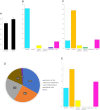Male infertility: what on earth is going on? Pilot international questionnaire study regarding clinical evaluation and fertility treatment for men
- PMID: 36065802
- PMCID: PMC9578063
- DOI: 10.1530/RAF-22-0033
Male infertility: what on earth is going on? Pilot international questionnaire study regarding clinical evaluation and fertility treatment for men
Abstract
Infertility is a time-consuming and exhaustive process, which disproportionally affects women. Although concerns have been raised about deficiencies in clinical evaluation of infertile men, there is currently little published data documenting this. A SurveyMonkey questionnaire was therefore created to capture current clinical practice of fertility specialists working in IVF clinics. Responses were collected May - July 2021. 112 clinicians completed the pilot survey with respondents from Europe (n=49; 43.8%), Africa (n=39, 34.8%), North America (n=6; 5.4%), Asia (n=16; 14.3%), South America (n=1; 0.9%) and Australasia (n=1;0.9%). 41% fertility specialists (45/110) reported taking only a brief medical history and 24% reported that they never routinely examined infertile male patients. 54% fertility specialists also reported issues getting men to undertake diagnostic semen analysis. Treatment for male infertility spanned Assisted Reproductive Technology (ART), with themes of individualised medicine influencing treatment recommendations. 48.2% clinicians reported using empirical medical therapy (EMT) for unexplained male infertility. Notably, 3.6% respondents recommended testosterone treatment, despite likely negative impact on spermatogenesis. However, high levels of opportunistic general health advice were reported, including discussion of life exposures thought to be important for male reproductive health. This study adds novel evidence and highlights current deficiencies in clinical practice relating to male infertility. Evaluation of the infertile male using simple medical tools (detailed history taking and clinical examination) has the potential to identify treatable or reversible conditions and should be an immediate focus for education and improvement in Reproductive Medicine. Investment in research and development is much needed in the field of andrology, to develop effective non-ART treatment options for male infertility.
Figures




References
-
- Agarwal A, Finelli R, Selvam MKP, Leisegang K, Majzoub A, Tadros N, Ko E, Parekh N, Henkel R, Durairajanayagam Det al.2021A global survey of reproductive specialists to determine the clinical utility of oxidative stress testing and antioxidant use in male infertility. World Journal of Men’s Health 39470–488. (10.5534/wjmh.210025) - DOI - PMC - PubMed
-
- Barratt CLR, De Jonge CJ, Anderson RA, Eisenberg ML, Garrido N, Rautakallio Hokkanen S, Krausz C, Kimmins S, O’Bryan MK, Pacey AAet al.2021A global approach to addressing the policy, research and social challenges of male reproductive health. Human Reproduction Open 2021 hoab009. (10.1093/hropen/hoab009) - DOI - PMC - PubMed
LinkOut - more resources
Full Text Sources

